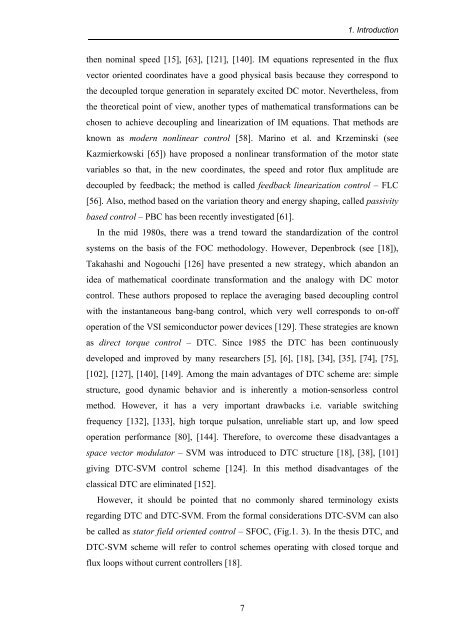Direct Power and Torque Control of AC/DC/AC Converter-Fed ...
Direct Power and Torque Control of AC/DC/AC Converter-Fed ...
Direct Power and Torque Control of AC/DC/AC Converter-Fed ...
Create successful ePaper yourself
Turn your PDF publications into a flip-book with our unique Google optimized e-Paper software.
1. Introduction<br />
then nominal speed [15], [63], [121], [140]. IM equations represented in the flux<br />
vector oriented coordinates have a good physical basis because they correspond to<br />
the decoupled torque generation in separately excited <strong>DC</strong> motor. Nevertheless, from<br />
the theoretical point <strong>of</strong> view, another types <strong>of</strong> mathematical transformations can be<br />
chosen to achieve decoupling <strong>and</strong> linearization <strong>of</strong> IM equations. That methods are<br />
known as modern nonlinear control [58]. Marino et al. <strong>and</strong> Krzeminski (see<br />
Kazmierkowski [65]) have proposed a nonlinear transformation <strong>of</strong> the motor state<br />
variables so that, in the new coordinates, the speed <strong>and</strong> rotor flux amplitude are<br />
decoupled by feedback; the method is called feedback linearization control – FLC<br />
[56]. Also, method based on the variation theory <strong>and</strong> energy shaping, called passivity<br />
based control – PBC has been recently investigated [61].<br />
In the mid 1980s, there was a trend toward the st<strong>and</strong>ardization <strong>of</strong> the control<br />
systems on the basis <strong>of</strong> the FOC methodology. However, Depenbrock (see [18]),<br />
Takahashi <strong>and</strong> Nogouchi [126] have presented a new strategy, which ab<strong>and</strong>on an<br />
idea <strong>of</strong> mathematical coordinate transformation <strong>and</strong> the analogy with <strong>DC</strong> motor<br />
control. These authors proposed to replace the averaging based decoupling control<br />
with the instantaneous bang-bang control, which very well corresponds to on-<strong>of</strong>f<br />
operation <strong>of</strong> the VSI semiconductor power devices [129]. These strategies are known<br />
as direct torque control – DTC. Since 1985 the DTC has been continuously<br />
developed <strong>and</strong> improved by many researchers [5], [6], [18], [34], [35], [74], [75],<br />
[102], [127], [140], [149]. Among the main advantages <strong>of</strong> DTC scheme are: simple<br />
structure, good dynamic behavior <strong>and</strong> is inherently a motion-sensorless control<br />
method. However, it has a very important drawbacks i.e. variable switching<br />
frequency [132], [133], high torque pulsation, unreliable start up, <strong>and</strong> low speed<br />
operation performance [80], [144]. Therefore, to overcome these disadvantages a<br />
space vector modulator – SVM was introduced to DTC structure [18], [38], [101]<br />
giving DTC-SVM control scheme [124]. In this method disadvantages <strong>of</strong> the<br />
classical DTC are eliminated [152].<br />
However, it should be pointed that no commonly shared terminology exists<br />
regarding DTC <strong>and</strong> DTC-SVM. From the formal considerations DTC-SVM can also<br />
be called as stator field oriented control – SFOC, (Fig.1. 3). In the thesis DTC, <strong>and</strong><br />
DTC-SVM scheme will refer to control schemes operating with closed torque <strong>and</strong><br />
flux loops without current controllers [18].<br />
7
















![[TCP] Opis układu - Instytut Sterowania i Elektroniki Przemysłowej ...](https://img.yumpu.com/23535443/1/184x260/tcp-opis-ukladu-instytut-sterowania-i-elektroniki-przemyslowej-.jpg?quality=85)
